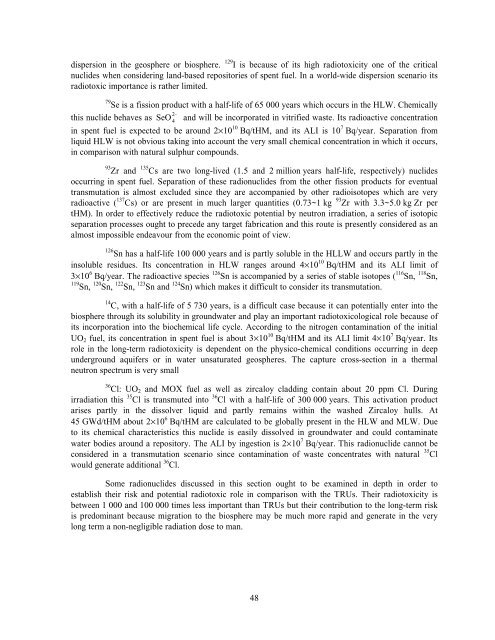COMPLETE DOCUMENT (1862 kb) - OECD Nuclear Energy Agency
COMPLETE DOCUMENT (1862 kb) - OECD Nuclear Energy Agency
COMPLETE DOCUMENT (1862 kb) - OECD Nuclear Energy Agency
Create successful ePaper yourself
Turn your PDF publications into a flip-book with our unique Google optimized e-Paper software.
dispersion in the geosphere or biosphere. 129 I is because of its high radiotoxicity one of the critical<br />
nuclides when considering land-based repositories of spent fuel. In a world-wide dispersion scenario its<br />
radiotoxic importance is rather limited.<br />
79 Se is a fission product with a half-life of 65 000 years which occurs in the HLW. Chemically<br />
2−<br />
this nuclide behaves as SeO 4<br />
and will be incorporated in vitrified waste. Its radioactive concentration<br />
in spent fuel is expected to be around 2×10 10 Bq/tHM, and its ALI is 10 7 Bq/year. Separation from<br />
liquid HLW is not obvious taking into account the very small chemical concentration in which it occurs,<br />
in comparison with natural sulphur compounds.<br />
93 Zr and 135 Cs are two long-lived (1.5 and 2 million years half-life, respectively) nuclides<br />
occurring in spent fuel. Separation of these radionuclides from the other fission products for eventual<br />
transmutation is almost excluded since they are accompanied by other radioisotopes which are very<br />
radioactive ( 137 Cs) or are present in much larger quantities (0.73~1 kg 93 Zr with 3.3~5.0 kg Zr per<br />
tHM). In order to effectively reduce the radiotoxic potential by neutron irradiation, a series of isotopic<br />
separation processes ought to precede any target fabrication and this route is presently considered as an<br />
almost impossible endeavour from the economic point of view.<br />
126 Sn has a half-life 100 000 years and is partly soluble in the HLLW and occurs partly in the<br />
insoluble residues. Its concentration in HLW ranges around 4×10 10 Bq/tHM and its ALI limit of<br />
3×10 6 Bq/year. The radioactive species 126 Sn is accompanied by a series of stable isotopes ( 116 Sn, 118 Sn,<br />
119 Sn, 120 Sn, 122 Sn, 123 Sn and 124 Sn) which makes it difficult to consider its transmutation.<br />
14 C, with a half-life of 5 730 years, is a difficult case because it can potentially enter into the<br />
biosphere through its solubility in groundwater and play an important radiotoxicological role because of<br />
its incorporation into the biochemical life cycle. According to the nitrogen contamination of the initial<br />
UO 2 fuel, its concentration in spent fuel is about 3×10 10 Bq/tHM and its ALI limit 4×10 7 Bq/year. Its<br />
role in the long-term radiotoxicity is dependent on the physico-chemical conditions occurring in deep<br />
underground aquifers or in water unsaturated geospheres. The capture cross-section in a thermal<br />
neutron spectrum is very small<br />
36 Cl: UO 2 and MOX fuel as well as zircaloy cladding contain about 20 ppm Cl. During<br />
irradiation this 35 Cl is transmuted into 36 Cl with a half-life of 300 000 years. This activation product<br />
arises partly in the dissolver liquid and partly remains within the washed Zircaloy hulls. At<br />
45 GWd/tHM about 2×10 6 Bq/tHM are calculated to be globally present in the HLW and MLW. Due<br />
to its chemical characteristics this nuclide is easily dissolved in groundwater and could contaminate<br />
water bodies around a repository. The ALI by ingestion is 2×10 7 Bq/year. This radionuclide cannot be<br />
considered in a transmutation scenario since contamination of waste concentrates with natural 35 Cl<br />
would generate additional 36 Cl.<br />
Some radionuclides discussed in this section ought to be examined in depth in order to<br />
establish their risk and potential radiotoxic role in comparison with the TRUs. Their radiotoxicity is<br />
between 1 000 and 100 000 times less important than TRUs but their contribution to the long-term risk<br />
is predominant because migration to the biosphere may be much more rapid and generate in the very<br />
long term a non-negligible radiation dose to man.<br />
48
















